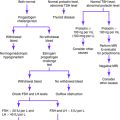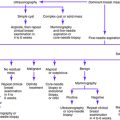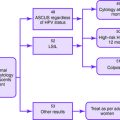Chapter 14 GALACTORRHEA
Galactorrhea is the inappropriate production of milk from the breast in the absence of pregnancy or beyond 6 to 12 months post partum in a nonbreastfeeding woman. The discharge of milk may be unilateral or bilateral, may be intermittent or persistent, and may vary in volume. Galactorrhea may also occur in boys and men and in infants and teenage girls.
Key Historical Features
✓ Unilateral or bilateral presence
✓ Medical history, particularly thyroid disorders or renal failure
✓ Surgical history, especially recent chest surgery
✓ Family history, especially thyroid disorders or multiple endocrine neoplasia, which increase the risk for galactorrhea
Key Physical Findings
✓ Poor growth or short stature, suggestive of hypothyroidism, hypopituitarism, or chronic renal failure
✓ Acromegaly or gigantism, suggestive of pituitary tumor
✓ Breast examination for nodules and discharge and determination of whether the discharge is from one or multiple ducts
✓ Cardiac examination for bradycardia suggestive of hypothyroidism or tachycardia suggestive of thyrotoxicosis
✓ Skin examination for dry skin, coarse hair, and myxedema, suggestive of hypothyroidism, or for hirsutism and acne, suggestive of hyperandrogenism
✓ Head and neck examination for goiter, suggestive of hypothyroidism
✓ Eye examination for visual field defect or papilledema, suggestive of pituitary tumor or intracranial mass
✓ Neurologic examination for hand tremor, suggestive of thyrotoxicosis, or for a cranial neuropathy, suggestive of pituitary tumor or intracranial mass
Suggested Work-Up
The evaluation of galactorrhea should proceed in a stepwise manner and be guided by findings from the history and physical examination.
| Pregnancy test | To evaluate for pregnancy in women of childbearing age |
| Serum prolactin measurement | To evaluate for pituitary adenoma |
| Thyroid-stimulating hormone (TSH) | To evaluate for hypo- or hyperthyroidism |
Additional Work-Up
| Measurement of follicle-stimulating hormone (FSH), luteinizing hormone (LH), and dehydroepiandrosterone sulfate (DHEAS) levels | To evaluate for hyperandrogenism when it is suggested by history and physical examination |
| Measurement of blood urea nitrogen (BUN) and creatinine levels | When chronic renal failure is suggested by history and physical examination |
| MRI of brain with gadolinium | When intracranial mass is suggested by history and physical examination |
Benjamin F. Normal lactation and galactorrhea. Clin Obstet Gynecol. 1994;37:887-897.
Falkenberry SS. Nipple discharge. Obstet Gynecol Clin. 2002;29:21-29.
Jardines L. Management of nipple discharge. Am Surg. 1996;62:119-122.
Leung AKC, Pacaud D. Diagnosis and management of galactorrhea. Am Fam Physician. 2004;70:543-550.
Luciano AA. Clinical presentation of hyperprolactinemia. J Reprod Med. 1999;44(12 Suppl):1085-1090.
Serri O, Chik CL, Ur E, et al. Diagnosis and management of hyperprolactinemia. CMAJ. 2003;169:575-581.
Spack NP, Neinstein LS. Galactorrhea. In: Neinstein LS, editor. Adolescent Health Care: A Practical Guide. 4th. Philadelphia: Lippincott Williams & Wilkins; 2002:1045-1051.





